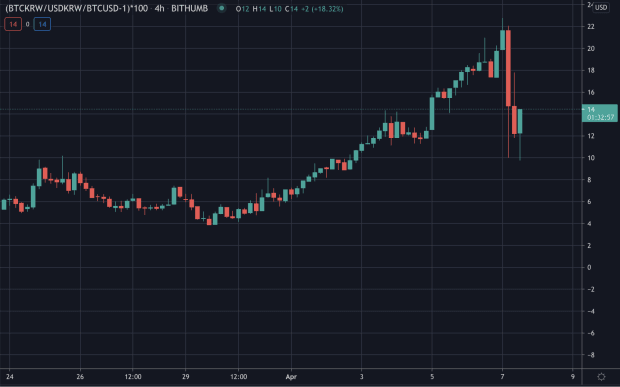Bitcoin often trades at a premium in South Korea; what happens when this bullish spread quickly dissipates?
The Kimchi premium—the spread between Bitcoin price on South Korean exchanges and Western exchanges—has always been an indicator attracting people’s attention in the bull market. The source of this spread is rooted in the inability to easily get a substantial amount of USD out of the country due to institutional frictions. Thus, this lack of arbitrage opportunities coupled with a huge demand for bitcoin among Koreans makes bitcoin trade at a premium on Korean exchanges when speculative frenzy hits the masses.
As with any bubble, at one point, when money inflows stop propping up the price, it is going to crash or at least correct somewhat. Sometimes, even a small pin is enough for the bubble to start deflating. This is exactly what happened today when Upbit suspended its deposits and withdrawals. The premium has fallen from 21 percent and hit 10 percent at its lowest point.
This is not the first time this bubble emerged and popped. In the peak of the 2017–2018 bull run the Kimchi premium reached 51 percent before it all came crashing down. Caution from this event is one of the reasons why the market has thrown a tantrum today. Traders see the Kimchi premium correction as a top signal and the harbinger of an overall market correction.
However, this is exactly a case of the tail wagging the dog. According to CoinGecko, the total bitcoin trading volume of the five major Korean exchanges—Bithumb, Upbit, Coinone, GOPAX, Corbit—makes up to 3.2 percent of the global bitcoin trading volume. Even in a case of the collapse of the bubble on Korean exchanges, it should not affect the global price much. Local bubbles come and go, which is not that significant.
What is significant, however, is the attention people pay to these sorts of things. Risk-on assets such as bitcoin are dominated by narratives and the Kimchi premium narrative is still a powerful one, if the amount of major media outlets and Twitter accounts mentioning it is any indicator. As with any narrative, though, it usually takes several invalidations for it to stop occupying people’s minds.
Will today’s premium correction make the premium disappear? Probably not. The bullish narratives for bitcoin are still untouched, the demand for bitcoin didn’t go anywhere, and the institutional frictions to withdraw money from the country are still in place. All this makes a perfect cocktail for the bubble to continue existing.
It is also worth noting that the Kimchi premium is not specific to bitcoin and is present for some other cryptocurrencies too, reflecting the arbitrage opportunities taken by traders and the overall bullish sentiment among Koreans.
The Kimchi premium can be a good and reliable indicator of the demand for bitcoin when taken within the context of its origin and combined with other factors affecting bitcoin’s price. On the other hand, used separately, it can give birth to false narratives and bring a lot of misinformation and damage. As with any indicator, one should be cautious to use it and never make any investment decisions based on this particular piece of data alone.
This is a guest post by Lex Moskovski. Opinions expressed are entirely their own and do not necessarily reflect those of BTC, Inc. or Bitcoin Magazine.





 BTC-USD
BTC-USD  ETH-USD
ETH-USD  LTC-USD
LTC-USD  XRP-USD
XRP-USD